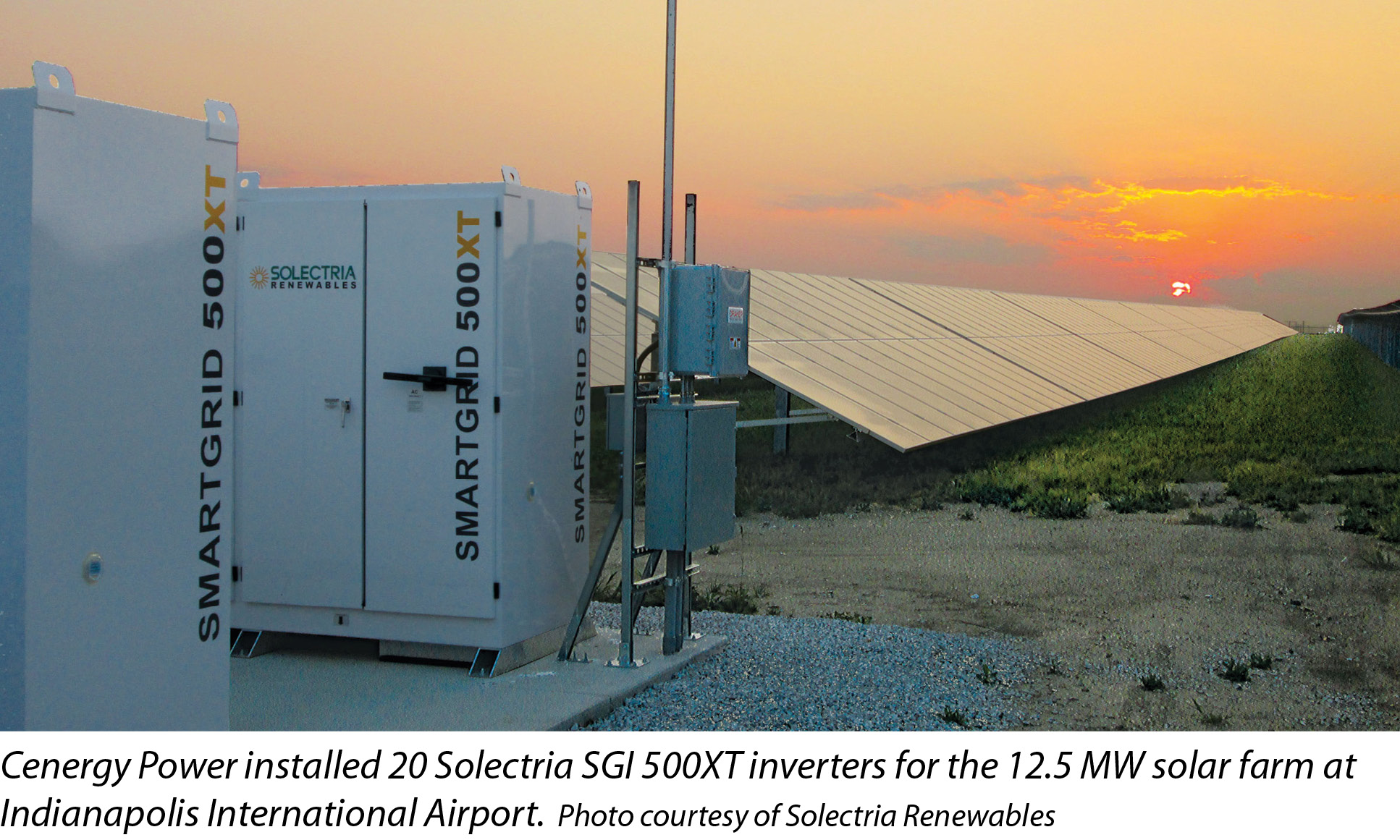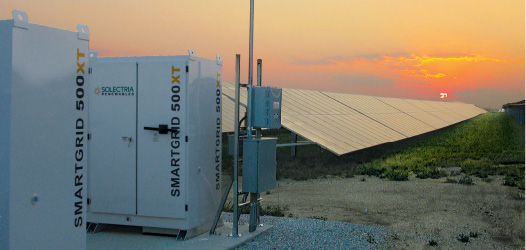

301 Moved Permanently
The solar inverter is the workhorse of a photovoltaic array. Although often evaluated in terms of constraints in system design, string size and points of failure, the inverter has evolved into a gateway to the operations and health of the solar PV plant. It provides information about and access to the facility to an ever-expanding circle of stakeholders.
Consider Principal Solar Inc.’s (PSI) Powerhouse One Unit 4, which was directly in the path of at least one of the two tornadoes that struck Lincoln County, Tenn., the evening of April 28. Matthew Thompson, executive director of the Principal Solar Institute, PSI’s nonprofit research arm, reports that while the storm wall was not on the ground as it passed over the site, it produced heavy rain and small hail.
“The solar operations were observed to start normally at sunrise on April 29, and the plant began operation without incident,” Thompson says. “However, the storm did extensive damage to Fayetteville Public Utilities’ distribution system, leaving 18,000 customers without power.”
Subsequent efforts to repair the grid in Lincoln County created instabilities that could not be tolerated by inverters at Powerhouse One, which was knocked offline.
“Operations were restored by a manual reset, and the inverter vendor was consulted for root-cause analysis,” Thompson says. “That analysis led to widening the operational tolerance of the inverters and updating the software to allow remote reset for the site.”
PSI is building a portfolio of solar assets from all over the country and depends on remote information access to oversee and manage these investments. The importance of inverters as the point of contact with PV assets will only increase as this portfolio grows.

A new world
One of the key drivers in the U.S. solar inverter marketplace is likely to be increasing competition by foreign firms angling for a piece of the lucrative and growing solar sector. While many European firms have successfully made this transition, the U.S. is about to experience an influx of competition from Asian inverter manufacturers, particularly Chinese firms.
Cormac Gilligan, senior PV market analyst at U.K.-based IHS Technology, says the competition is expected to bring down prices, however.
“In the next five years, I expect average inverter pricing to decrease on average by 10 percent per year in the U.S. - somewhere in between European and Japanese inverter pricing,” Gilligan says. “As the market is forecast to increase in shipment terms over the next few years, this should accommodate some of the added competition by European, Chinese and Japanese suppliers.”
Gilligan says that there are already a few suppliers who have a reasonably significant export market outside their domestic markets. In terms of Chinese suppliers, Sungrow has the largest presence and biggest global footprint outside China in markets such as Germany, the U.S. and other Asian countries. Other Chinese suppliers such as Samil Power and Growatt have a reasonable presence in some markets such as the U.K. and Australia, Gilligan says, because these are usually the first ones Chinese suppliers have entered due to the large residential markets.
“New suppliers will enter into residential and commercial first as it is normally quite difficult to enter into the utility-scale until you build relationships with the leading integrators,” he says.
An influx of competitors from Asia is not necessarily going to bring on a price freefall as it did with PV modules. For one thing, the business of manufacturing electromechanical devices with hundreds of components operates on different scales from solid-state wafers, cells and modules. Also, inverters have to incorporate complex firmware and even software features to enable them to operate in the grid-connected market.
“New and updated standards and regulations such as ‘Rule 21’ in California may provide some short-term supply bottlenecks, but I expect the majority of suppliers should be able to meet the requirements based on the lessons learned in Europe, and this should be only a short-term issue,” Gilligan says.
Because inverters are not a commodity product, suppliers entering the U.S. solar sector are able to bring their engineering capabilities to bear in order to distinguish themselves from the competition. While prices drop, there will still be opportunities to compete on the basis of features and quality. Many companies that have taken the plunge describe it as an opportunity to add value.
Last year, Switzerland-based ABB acquired Power-One for over $1 billion. Paolo Casini, vice president of marketing at ABB’s solar group, says ABB is banking on solar PV being among the fastest-growing global markets for future power supply. Characterizing the market as relatively immature, he says the company sees an opportunity to take a leading position in a value-added segment of the solar supply chain.
“Today, the most critical element in the solar PV value chain is the inverter,” Casini says. “This is expected to be the case in the future. Inverters are the intelligence of the PV system, not only converting DC power to AC, but also controlling the system while monitoring grid behavior to support grid stabilization, thus requiring constant innovation and reducing the risk of inverters becoming a commodity.”
Lou Lambruschi, marketing services and e-business manager for Parker Hannifin Corp., says because the company moved into the solar inverter market from the industrial controls industry, it was able to bring some of that technology along. In particular, the company was able to leverage cooling systems developed for other industrial applications.
The cooling system for the company’s 890GT-S outdoor central inverter was developed within Parker in collaboration with another division. Initially, it was used in Parker’s grid-tie inverters for energy storage and in high-power variable frequency drives for industry.
Lambruschi says the use of non-conductive fluid will not cause a catastrophic failure if a leak occurs. Also, because the system does not cool the heat sinks to a less-than-ambient temperature, condensation will not occur within the enclosure. Another advantage of the two-phase cooling system design, he says, is that it responds quickly to demand, minimizing temperature excursions within the insulated gate bipolar transistors (IGBTs) - and this can result in longer IGBT life.
The enclosure, which carries an IP65 rating, was designed specifically for the AC890GT-S central solar inverter and is also used for the AC890GT-B energy storage PCS. Goals were a small footprint to allow skid mounting with a transformer, and accessibility - allowing service and routine maintenance to be performed without entering the enclosure.
Babysitting business
Some suppliers of inverters and solar power electronics are looking beyond hardware for opportunities to add value to the solar sector, particularly as distributed PV and third-party ownership become commonplace.
Mark Abrams, director of hardware in Enphase’s product management group, points out that his company’s micro-inverters are sold with monitoring included. The company receives about 400 GB of data from customer solar installations every day. It does not require much imagination to see that data and expertise as a possible business.
“A lot of solar asset owners do not want to be in the operations and maintenance (O&M) business,” Abrams says. “Outsourcing that service to us is certainly an attractive possibility.”
Lior Handelsman, founder of Israel-based SolarEdge and its vice president of marketing and product development, says information is the future of the solar inverter business.
“With data and telemetry from every module, O&M providers have the ability to monitor every aspect of the asset remotely,” Handelsman says.
Nevertheless, many stakeholders find the sheer volume of installation data daunting.
“For most of our commercial customers, we have a babysitting mode,” Handelsman says. “We can monitor the customer’s system from our data center for a period of time until the customer is ready to take over. It is not out of the question that we would consider a babysitting service as a business direction in the future.”
Adrian de Luca, senior vice president of sales and marketing for Locus Energy, says analyzing the vast qualities of data supplied by inverters and module-level electronics from PV plants is the key to being able to use it effectively for O&M and asset management.
“Software companies can add value in distributed PV by not just collecting data, but really crunching the numbers,” de Luca says.
Going forward, he predicts the service burden is going to fall on third parties who really want that business. Locus Energy is positioning itself to provide the software tools in its PVIQ risk-mitigation suite to enable those who take up the service burden to make sense of the data.
Moreover, de Luca says, plant performance data needs to be cross-referenced with environmental and solar irradiance data in order to pinpoint specific loss factors. Waterfall analysis, using a range of algorithms and empirical models, can remotely determine the root causes of a solar PV system’s performance shortfalls. These reasons may include factors such as weather uncertainty, snow downtime, shading, equipment downtime, equipment degradation and inverter problems. R
Market Report: Inverters
Solar Inverters Face The Demands Of A New Day With More Functionality
By Michael Puttré
Cost competition and performance requirements are forcing inverter suppliers to get smart.


si body si body i si body bi si body b
si depbio
- si bullets
si sh
si subhead
pullquote
si first graph
si sh no rule
si last graph